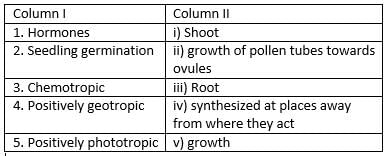Class 10 Exam > Class 10 Tests > Science Class 10 > Test: Chemical Coordination In Plants - Class 10 MCQ
Test: Chemical Coordination In Plants - Class 10 MCQ
Test Description
10 Questions MCQ Test Science Class 10 - Test: Chemical Coordination In Plants
Test: Chemical Coordination In Plants for Class 10 2025 is part of Science Class 10 preparation. The Test: Chemical Coordination In Plants questions and answers have been
prepared according to the Class 10 exam syllabus.The Test: Chemical Coordination In Plants MCQs are made for Class 10 2025 Exam. Find important
definitions, questions, notes, meanings, examples, exercises, MCQs and online tests for Test: Chemical Coordination In Plants below.
Solutions of Test: Chemical Coordination In Plants questions in English are available as part of our Science Class 10 for Class 10 & Test: Chemical Coordination In Plants solutions in
Hindi for Science Class 10 course. Download more important topics, notes, lectures and mock
test series for Class 10 Exam by signing up for free. Attempt Test: Chemical Coordination In Plants | 10 questions in 10 minutes | Mock test for Class 10 preparation | Free important questions MCQ to study Science Class 10 for Class 10 Exam | Download free PDF with solutions
Test: Chemical Coordination In Plants - Question 1
How do plant cells achieve shape changes necessary for movement?
Detailed Solution for Test: Chemical Coordination In Plants - Question 1
Test: Chemical Coordination In Plants - Question 2
In plants, what is the main mechanism used for communication between cells to convey information about touch?
Detailed Solution for Test: Chemical Coordination In Plants - Question 2
Test: Chemical Coordination In Plants - Question 3
What distinguishes the movement in a sensitive plant from the movement in a seedling?
Detailed Solution for Test: Chemical Coordination In Plants - Question 3
Test: Chemical Coordination In Plants - Question 4
Which plant hormone is synthesized at the shoot tip, aids in cell elongation, and is involved in phototropism?
Detailed Solution for Test: Chemical Coordination In Plants - Question 4
Test: Chemical Coordination In Plants - Question 5
What type of movement in plants is related to growth and can be either towards or away from stimuli?
Detailed Solution for Test: Chemical Coordination In Plants - Question 5
Test: Chemical Coordination In Plants - Question 6
What type of plant movement is characterized by an immediate response to the stimulus and involves the use of electrical-chemical means for cell-to-cell communication?
Detailed Solution for Test: Chemical Coordination In Plants - Question 6
Test: Chemical Coordination In Plants - Question 7
What is the primary function of Gibberellin in plants?
Detailed Solution for Test: Chemical Coordination In Plants - Question 7
Test: Chemical Coordination In Plants - Question 8
What type of movement in plants involves growth responses towards or away from gravity?
Detailed Solution for Test: Chemical Coordination In Plants - Question 8
Detailed Solution for Test: Chemical Coordination In Plants - Question 9
Detailed Solution for Test: Chemical Coordination In Plants - Question 10
|
83 videos|438 docs|74 tests
|
Information about Test: Chemical Coordination In Plants Page
In this test you can find the Exam questions for Test: Chemical Coordination In Plants solved & explained in the simplest way possible.
Besides giving Questions and answers for Test: Chemical Coordination In Plants, EduRev gives you an ample number of Online tests for practice





















